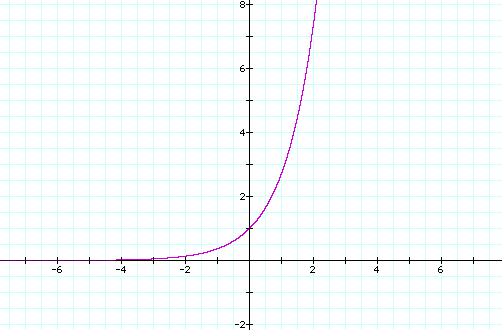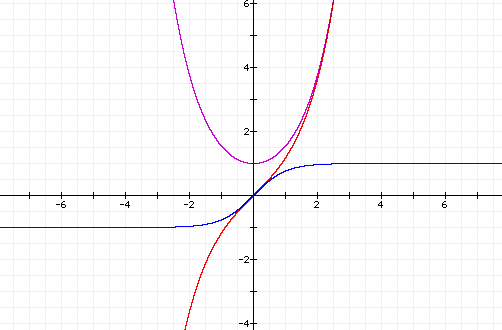 Special Functions library
Special Functions library Special Functions library
Special Functions libraryThe exponential funtion is defined, for all object for which this makes sense, as the power series ![]() , with
, with ![]() (and
(and ![]() by definition) being the factorial of
by definition) being the factorial of ![]() . In particular, the exponential function is well defined for real numbers, complex number, quaternions, octonions, and matrices of complex numbers, among others.
. In particular, the exponential function is well defined for real numbers, complex number, quaternions, octonions, and matrices of complex numbers, among others.

Graph of exp on R


Real and Imaginary parts of exp on C
The hyperbolic functions are defined as power series which can be computed (for reals, complex, quaternions and octonions) as:
Hyperbolic cosine: ![]()
Hyperbolic sine: ![]()
Hyperbolic tangent: ![]()

Trigonometric functions on R (cos: purple; sin: red; tan: blue)

Hyperbolic functions on r (cosh: purple; sinh: red; tanh: blue)
The hyperbolic sine is one to one on the set of real numbers, with range the full set of reals, while the hyperbolic tangent is also one to one on the set of real numbers but with range ![]() , and therefore both have inverses. The hyperbolic cosine is one to one from
, and therefore both have inverses. The hyperbolic cosine is one to one from ![]() onto
onto ![]() (and from
(and from ![]() onto
onto ![]() ); the inverse function we use here is defined on
); the inverse function we use here is defined on ![]() with range
with range ![]() .
.
The inverse of the hyperbolic tangent is called the Argument hyperbolic tangent, and can be computed as ![]() .
.
The inverse of the hyperbolic sine is called the Argument hyperbolic sine, and can be computed (for ![]() ) as
) as ![]() .
.
The inverse of the hyperbolic cosine is called the Argument hyperbolic cosine, and can be computed as ![]() .
.
Revised 03 Feb 2003
© Copyright Hubert Holin 2001-2003. Permission to copy, use, modify, sell and distribute this document is granted provided this copyright notice appears in all copies. This software is provided "as is" without express or implied warranty, and with no claim as to its suitability for any purpose.